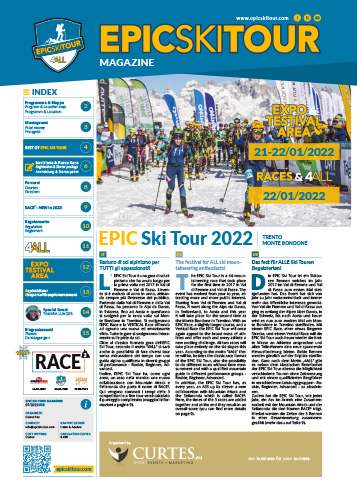GENERAL INFORMATION ABOUT EPIC SKI TOUR
1 – Organisation
Curtes Sportevents Marketing Sas

2 – Conditions for participation
Participants must have at least 18 years at the date of the first race of the event. Participants have to satisfy all the physical conditions required for this event with high competitive level and have present, when picking up their starting number, a valid certificate of sports doctor. In any other case the start is not allowed. In this case the organizational contribution is not returned. Participants accept without the responsibility conditions, relinquishing any legal action against the Organizing Committee. Participation is at your own risk!
3 – Locations, date, time, start-finish
The event will take place in the Gran San Bernardo Valley in the municipalities of Saint Rhémy en Bosses, Saint Oben and Etroubles – Aosta Valley.
The start will take place in multiple groups:
Friday, 15th February 2020: 9.00 am, Loc. Flassin Foyer de Fond
4 – Time Limits
The race has a maximum time.
Participants who do not reach the various intermediate / arrival points in the allotted time are in any case excluded and do not appear in the final ranking.
5 – Division into age groups
- Women: Overall, Master (> 40)
- Men: Overall, Master (> 40), Grand Master (> 50)
6 – Prize Money
In total there is a prize money of € 2.700,00. In addtion there will be gift prizes with a total value of € 2.000,00
7 – Distribution Starter Packages
The distribution of the starter packages will take place:
- Friday, 14th February 2020 from 2.00 pm to 7.00 pm in the race office in Etroubles
- Saturday, 15th February 2020 from 7.00 am to 8.30 am in the Start/Finish area at the Foyer de Fond – Loc. Flassin in Saint-Rhémy-en-Bosses
Please bring with you a valid medical certificate. The starting numbers can not be given to other people.
8 – Prize-Giving
The Prize-Giving ceremony will take place on 15.02.2020 at 2.00 pm at the Foyer de Fond – Loc. Flassin Saint-Rhémy-en-Bosses
9 – Publication of the ranking
The ranking is published on the internet demo.epicskitour.com
10 – Timing
SDAM is responsible for timekeeping. It will be used an electronic chip system.
ENROLLMENT
1 – Registration
Online registration (www.epicskitour.com) with payment by credit card, Paypal or bank transfer.
INFO:
info@epicskitour.com
The enrollment is considered valid only after receiving the payment of the enrollment fee.
The registration is personal. For changing the name of an athlete, a processing fee of € 25.00 will be charged.
2 – Registration Fee
The registration fee is:
30,00 € + 10,00 € deposit for the chip
(the chip has to be returned at the end of the races for the refund of the deposit)
3 – Payment
The payment has to be on our bank account before the first race.
4 – Refund
If a participant does not show up at the start he/she has any right for a reimbursement of the registration fee. If the event does not take place for reasons of force majeure, extreme weather conditions or any other reason not indebted by the organization, the fee will not be refunded, nor recognized for the following year.
5 – Registration deadline
Enrollment will be closed on 13.02.2020.
In exceptional cases the OC can accept the enrollment of an athlete after the deadline.
INFO: info@epicskitour.com
EQUIPMENT
1- Skis
A pair of skis with metallic edges covering at least 90% of their length, and minimal width of at least 80 mm in the front, 60 mm under the boot and 70 mm in the rear part; ski length must be of at least 160cm for men and 150cm for women.
The skis will be measured according to the method “Rolling”.
2 – Boots
- Boots (only the shell) must cover the ankles and have notched soles in Vibram or an equivalent., the minimum notch depth is 4 mm.
- There must be at least 8 notches under the heel and 15 under the front part of the sole, with a minimum surface area of 1cm2 per notch.
- Each boot must have at least 2 independent closing
- Boots must be designed to be used with metallic
- Crosscountry ski boots and bindings or equivalents are strictly forbidden. The use of adhesive tape on the boots is forbidden.
- Modified boots by a second manufacturer are only allowed if there is a formal agreement between the two manufacturers, which is specified in the written information supplied with the modified part.
- The notched soles have to cover the 100% of the boot surface.
- Minimal weight for boots (shell and dry inner):
– Men: 500 grams, i.e. 1000 grams per pair
– Women: 450 grams, i.e. 900 grams per pair
3 – Bindings
Bindings which allow heel movement during ascents and are blocked for descents; they may or may not be equipped with security straps.
- The Binding-System must have a lateral and a front complete release system (the boot is completely separate from the ski).
- Boots and bindings must be set according to the instruction for use given by the manufacturer in order to guarantee optimum working of the release systems and the best protection of bindings and ski structure.
- Minimal weight for skis and bindings:
– Men: 750 grams, i.e. 1500 grams per pair.
– Women : 700 grams, i.e. 1400 grams per pair. - Mixed bindings (front part from one manufacturer and rear part from another one) are not allowed
4 – Ski Poles
A pair of alpine or cross-country ski poles (carbon or other material) of a maximum diameter of 25 mm, and with non-metallic baskets.
5 – Survival Blanket
A survival blanket with a minimum surface area of 1.80 m2, modifications subsequent to manufacture are not allowed. The term “survival blanket” is as defined by the manufacturer.
6 – DVA/ARVA
An avalanche, also called DVA or ARVA, that conforms to standard EN 300718 457 kHz frequency.
The DVA has to be equipped with a 3 antennas emission system.It has to be worn in a closed pocket (zipped lock only) opening on the inside of the racing suit, and at the belly level. The DVA must stay on during the hole race.
7 – Snow Shovel
The shovel mounted with the handle and the spoon has to have a minimum length of 50 cm. The spoon measures must be at least 0,04 m2 must not have undergone any changes.
8 – Snow Probe
A snow probe with min. length 240 mm and a diameter of 10 mm.
9 – Rucksack
A rucksack with sufficient capacity to hold all the equipment required by the regulation, with two posterior and/or lateral fastening straps for carrying skis. If the rucksack has an independent crampons pouch, the pouch must be securely fastened to the back of the rucksack (using Velcro straps, etc.). The rucksack crampon pocket must be opening from the back and not from the front (to avoid opening in case of fall).
10 – Skins
A pair of removable anti-slipping skins. The skins of wild animal origin are strictly forbidden. The skins have to cover at least 50% of the surface and 50% of the length of the ski. Everyone has to bring a second pair of skins with them (reserve).
11 – Clothing
Upper body clothing: three layers that fit the competitor well:
- 1 long or short-sleeved, body-hugging layer
- 1 ski suit with long-sleeves or a second layer with long-sleeves
- 1 breathable, long-sleeved wind breaker.
Lower body clothing: two long-legged layers that fit the competitor well
- 1 ski suit or ski pants
- 1 breathable wind breaker trousers
12 – Helmet
A helmet conforming to: UIAA 106 and EN 1077 classB standards or EN 12492 and EN 1077 classB standards. Helmets must be used (chin-strap has to be fastened) during the whole race (from the start to the finish line).
13 – Mobile Phone
Each athlete has to take with him during the race his mobile phone. The mobile phone must stay on during the entire race. You have to indicate your phone number during the enrollment.
14 – Various
- A pair of gloves that cover all the hand up to the wrist – to be worn throughout the duration of the race
- An UV-protection sunglasses
- A ski cap or headband
- A climbing harness
15 – Supplementary Equipment
- A pair of metallic crampons conform to UIAA standard 153, with at least, 10 spikes, the front two must adjust to fit the competitor’s boots. They must have original safety straps that should be properly fastened during all the crampons foot part of the race. When crampons are not worn on boots, they must be packed in the rucksack, with spikes facing each other.
- An additional upper body thermal fleece layer of clothing (4th layer with long sleeves), soft shell double with fleece that fits the competitor well. The 4th layer is thermal clothing which must have a minimum weight of 300 gr.
- A pair of windproof pants in the competitors size with minimum thermal padding 60gr per m2. Harness UIAA approved, unmodified.
- A head torch in full working order.
Equipment will be inspected at the finish line or at any other point on the course (without stopping the competitor, the controller takes note as the competitor goes past).
The competitor is totally responsible for his/her equipment. If a competitor has doubts about his/her equipment, he/she can have it checked by the jury at the end of the race briefing the day before the competition.
RACE
1 – Race Bibs
Must be placed in a good visible position (1 on the right leg, 1 on the back of the rucksack)
2 – Change Areas
Skins can be changed only in the designated areas without any external help. Fix and mobile check points will be set up along the race route, the race bibs of the athletes breaking this rule will be signaled by the jury for their immediate disqualification.
3 – Abandoning of equipment or rubbish
It is absolutely forbidden to throw away rubbish or leave equipment outside the change areas.
4 – Signage of the race route
It will be signaled by means of flags, reflecting tape, flashing and torch lights.
5 – Mutual help
In case of need, participant must help each other.
6 – Withdrawl
It is compulsory to communicate one’s withdrawal from the competition at the intermediate point or to staff members along the racetrack. The organization will arrange the transportation of the athletes back to the start area.





